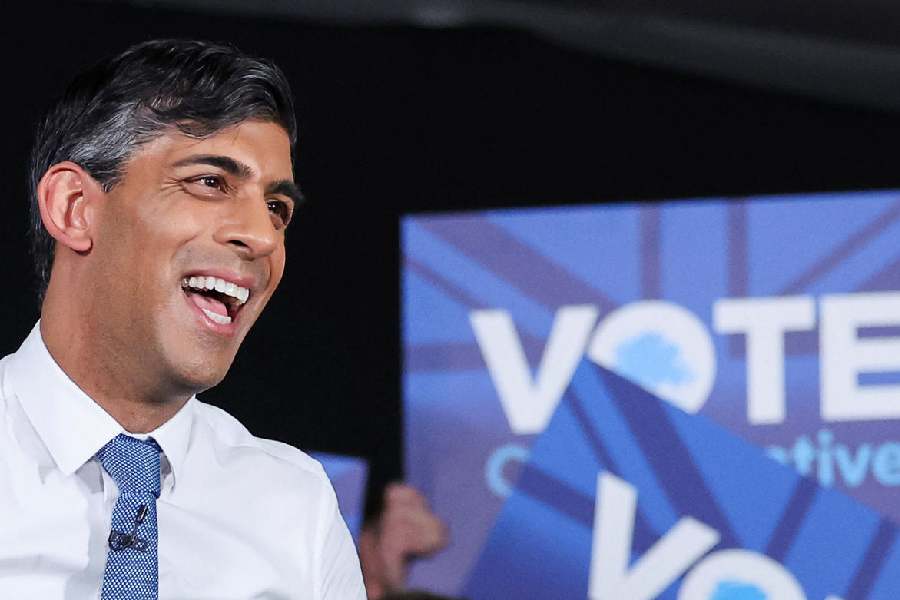The future of Rishi Sunak as Britain’s Prime Minister and leader of the Conservative Party hangs in the balance as polling booths opened across the UK on Thursday, with millions expected to turn out to cast their votes in the general election.
Sunak, 44, is up against voter angst towards the incumbent Tories after 14 years in power and has had to contend with trailing far behind 61-year-old Keir Starmer led Labour Party throughout the six-week campaign.
Both leaders wrapped up their poll pitches with contrasting messages — Sunak urging voters to not hand “tax-raising” Labour a “supermajority” and Starmer playing down the prospect of a landslide win for fear of a low turnout impacting the final outcome.
Candidates are being fielded for 650 constituencies across England, Scotland, Wales, and Northern Ireland, with 326 required for a majority in the first past the post system. Besides the two main parties, voters will be choosing from a list of candidates representing the Liberal Democrats, Green Party, Scottish National Party (SNP), SDLP, Democratic Unionist Party (DUP), Sinn Fien, Plaid Cymru, the anti-immigration Reform Party and several contesting as Independent.
Around 40,000 polling booths opened across the country at 7am local time as an estimated 46 million registered voters began turning out to mark a cross next to their chosen candidate on a paper ballot. Since this year, carrying an identification document to the polling booth has become compulsory in UK elections, which are open to all registered adult voters resident in the UK — including Indians as Commonwealth citizens. Several voters have already cast their vote in a postal ballot, which can also be handed in to their local councils if pending.
Once the votes are cast and the booths officially close at 10pm local time, the focus shifts to the definitive exit poll soon after which gives a fair snapshot of what can be expected UK-wide. Counting commences up and down the country right away, with the first results expected just before midnight local time.
“Stop Labour’s supermajority” is the central message British Prime Minister Sunak was trying to drive home as he wrapped up his campaign, even as most of the incumbent Conservatives all but conceded defeat in the general election.
“Labour will put up your taxes. Again and again and again,” posted Sunak on social media as the catch-all message to wind up the campaign trail.
The British Indian leader and his team's strategy in the final hours was to canvas their traditional voters to narrow the gap of a widely expected defeat after clear Tory majorities in the last three general elections. The Opposition dubbed it as fear tactics to jolt Tory voters into action, with the hope of keeping the Labour majority under that won by former prime minister Tony Blair led Labour Party in 1997 of 179 seats.
The Labour Party, meanwhile, was keen to override this message of its win as a foregone conclusion to fight against any complacency within the ranks and among its own voter base.
“It isn't 'job done',” cautioned Starmer.
Polling experts have forecast a low turnout, which stood at 67 per cent in the last general election in December 2019 when Johnson won a solid majority on his “get Brexit done” message. If opinion polls are to be believed, the incumbent Tories are in line to win anywhere between 53 and 150 seats, with Labour projected to win a landslide. This will lead to Keir Starmer taking over as Prime Minister, the first Labour leader after Gordon Brown to enter 10 Downing Street since 2010.
The last general election was held in December 2019, when Boris Johnson won 365 seats, giving him an 80-seat majority. Labour won 202 seats, the Scottish National Party (SNP) 48, the Liberal Democrats 11, the Democratic Unionist Party (DUP) eight, Sinn Fein seven, Plaid Cymru four, the SDLP two, the Alliance party one, and the Greens one.
The UK has a five-year general election cycle and Sunak had until January 2025 to go to the polls but chose a surprise summer election when he named July 4 as the date in May. It is the first time he is seeking the voters’ mandate, having been chosen Tory leader and Britain's first Indian heritage Prime Minister by the party membership following political turmoil in October 2022. It is also the first test at the ballot box for Keir Starmer, who took over from Jeremy Corbyn after Labour’s defeat in 2019.
Except for the headline, this story has not been edited by The Telegraph Online staff and has been published from a syndicated feed.










